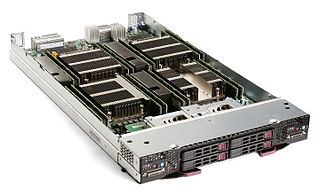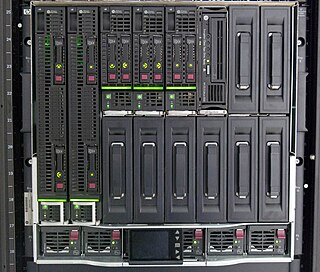Related Research Articles
Multiprotocol Label Switching (MPLS) is a routing technique in telecommunications networks that directs data from one node to the next based on labels rather than network addresses. Whereas network addresses identify endpoints, the labels identify established paths between endpoints. MPLS can encapsulate packets of various network protocols, hence the multiprotocol component of the name. MPLS supports a range of access technologies, including T1/E1, ATM, Frame Relay, and DSL.

Ethernet over twisted-pair technologies use twisted-pair cables for the physical layer of an Ethernet computer network. They are a subset of all Ethernet physical layers.
A network switch is networking hardware that connects devices on a computer network by using packet switching to receive and forward data to the destination device.
The Spanning Tree Protocol (STP) is a network protocol that builds a loop-free logical topology for Ethernet networks. The basic function of STP is to prevent bridge loops and the broadcast radiation that results from them. Spanning tree also allows a network design to include backup links providing fault tolerance if an active link fails.

A virtual local area network (VLAN) is any broadcast domain that is partitioned and isolated in a computer network at the data link layer. In this context, virtual refers to a physical object recreated and altered by additional logic, within the local area network. Basically, a VLAN behaves like a virtual switch or network link that can share the same physical structure with other VLANs while staying logically separate from them. Between network devices, VLANs work by applying tags to network frames and handling these tags in networking systems –creating the appearance and functionality of network traffic that is physically on a single network but acts as if it were split between separate networks. In this way, VLANs can keep network applications separate despite being connected to the same physical network, and without requiring multiple sets of cabling and networking devices to be deployed.
The Internetworking Operating System (IOS) is a family of proprietary network operating systems used on several router and network switch models manufactured by Cisco Systems. The system is a package of routing, switching, internetworking, and telecommunications functions integrated into a multitasking operating system. Although the IOS code base includes a cooperative multitasking kernel, most IOS features have been ported to other kernels, such as Linux and QNX, for use in Cisco products.

A blade server is a stripped-down server computer with a modular design optimized to minimize the use of physical space and energy. Blade servers have many components removed to save space, minimize power consumption and other considerations, while still having all the functional components to be considered a computer. Unlike a rack-mount server, a blade server fits inside a blade enclosure, which can hold multiple blade servers, providing services such as power, cooling, networking, various interconnects and management. Together, blades and the blade enclosure form a blade system, which may itself be rack-mounted. Different blade providers have differing principles regarding what to include in the blade itself, and in the blade system as a whole.

In computer networking, link aggregation is the combining of multiple network connections in parallel by any of several methods. Link aggregation increases total throughput beyond what a single connection could sustain, and provides redundancy where all but one of the physical links may fail without losing connectivity. A link aggregation group (LAG) is the combined collection of physical ports.

Catalyst is the brand for a variety of network switches, wireless controllers, and wireless access points sold by Cisco Systems. While commonly associated with Ethernet switches, a number of different types of network interfaces have been available throughout the history of the brand. Cisco acquired several different companies and rebranded their products as different versions of the Catalyst product line. The original Catalyst 5000 and 6000 series were based on technology acquired from Crescendo Communications. The 1700, 1900, and 2800 series Catalysts came from Grand Junction Networks, and the Catalyst 3000 series came from Kalpana in 1994.

EtherChannel is a port link aggregation technology or port-channel architecture used primarily on Cisco switches. It allows grouping of several physical Ethernet links to create one logical Ethernet link for the purpose of providing fault-tolerance and high-speed links between switches, routers and servers. An EtherChannel can be created from between two and eight active Fast, Gigabit or 10-Gigabit Ethernet ports, with an additional one to eight inactive (failover) ports which become active as the other active ports fail. EtherChannel is primarily used in the backbone network, but can also be used to connect end user machines.
In computer networking, jumbo frames are Ethernet frames with more than 1500 bytes of payload, the limit set by the IEEE 802.3 standard. The payload limit for jumbo frames is variable: while 9000 bytes is the most commonly used limit, smaller and larger limits exist. Many Gigabit Ethernet switches and Gigabit Ethernet network interface controllers and some Fast Ethernet switches and Fast Ethernet network interface cards can support jumbo frames.
Network load balancing is the ability to balance traffic across two or more WAN links without using complex routing protocols like BGP.
Port Aggregation Protocol (PAgP) is a Cisco Systems proprietary networking protocol, which is used for the automated, link aggregation of Ethernet switch ports, known as an EtherChannel. PAgP is proprietary to Cisco Systems. A similar protocol known as Link Aggregation Control Protocol (LACP) — released by the IEEE — is an industry standard and is not tied to a specific vendor.
The current portfolio of PowerConnect switches are now being offered as part of the Dell Networking brand: information on this page is an overview of all current and past PowerConnect switches as per August 2013, but any updates on current portfolio will be detailed on the Dell Networking page.

Private VLAN, also known as port isolation, is a technique in computer networking where a VLAN contains switch ports that are restricted such that they can only communicate with a given uplink. The restricted ports are called private ports. Each private VLAN typically contains many private ports, and a single uplink. The uplink will typically be a port connected to a router, firewall, server, provider network, or similar central resource.

A stackable switch is a network switch that is fully functional operating standalone but which can also be set up to operate together with one or more other network switches, with this group of switches showing the characteristics of a single switch but having the port capacity of the sum of the combined switches.
The Cisco Nexus series switches are modular and fixed port network switches designed for the data center. Cisco Systems introduced the Nexus Series of switches on January 28, 2008. The first chassis in the Nexus 7000 family is a 10-slot chassis with two supervisor engine slots and eight I/O module slots at the front, as well as five crossbar switch fabric modules at the rear. Beside the Nexus 7000 there are also other models in the Nexus range.

BladeSystem is a line of blade server machines from Hewlett Packard Enterprise that was introduced in June 2006.
The Cisco Supervisor Engine serves as the management card for modular Cisco switches that can also, in some cases, act as forwarding/routing element.

The Dell blade server products are built around their M1000e enclosure that can hold their server blades, an embedded EqualLogic iSCSI storage area network and I/O modules including Ethernet, Fibre Channel and InfiniBand switches.
References
- ↑ "Different Types of Network Switches". Cisco. Retrieved 2022-03-31.
- ↑ "Modular switches: advantages and disadvantages". NetworkTigers News. 2021-02-13. Retrieved 2022-03-31.
- ↑ "Understanding the Different Types of Network Switches & Ethernet Switches" . Retrieved 18 March 2019.
- ↑ "Cisco Catalyst 9400 Supervisor Engine-1" (PDF). Retrieved 18 March 2019.